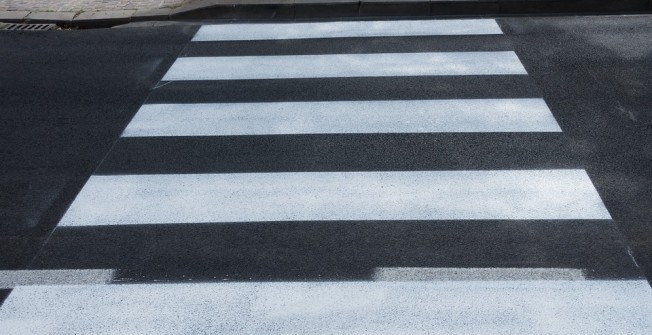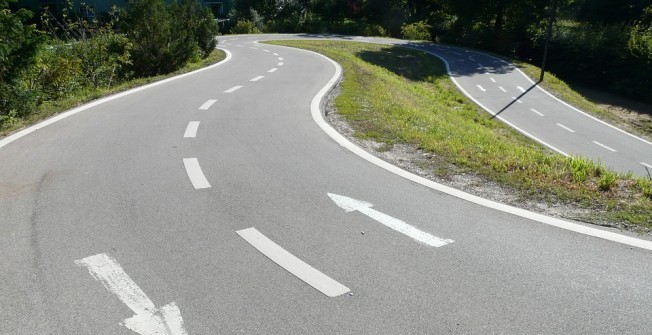We offer a Free quote and UK design service, get in touch today.
We offer a Free quote and UK design service, get in touch today.



Our specialists carry out the installation of thermoplastic road markings in Whimple EX5 2 to create a safer environment for road users and improve road safety.
We have years of experience within the thermoplastic line marking industry and can offer high-quality installations which are durable and long-lasting.
There are a number of different colours available for the preformed thermoplastic paint installation, which means we're able to install different types of roadway markings: from give way lines to double yellow lines.
Whatever road line markings you require, please let our team know and we'll assist you.
We work with a number of companies and individuals to create professional markings for roadways.
If you'd like to discuss the prices of our preformed thermoplastic marking products, please fill in our contact box and our local team will provide you with a free quotation.
Thermoplastic road marking is a highly durable type of road marking material that is widely used for traffic management and safety on roadways. It's applied by melting the thermoplastic material and then applying it to the road surface.
There are several types of thermoplastic road markings, each serving a specific purpose. Here are some common types:
Thermoplastic road markings are preferred for their durability, high reflectivity, and resistance to wear and weather conditions.
The specific type of marking used depends on the road's purpose, traffic patterns, and safety considerations. Road authorities and transportation departments carefully plan and implement these markings to ensure efficient and safe traffic flow.
The average cost for road marking installation is £28,000- £43,000 but it varies depending on the size of the job and location.
The above is a rough cost as each job will have to be quoted individually and our team will be happy to provide you with a quote for these works.
When pricing these works, we will need to find out more about the size of the project and site location.
Using thermoplastic road markings offers several benefits compared to traditional paint or other road marking materials.
Thermoplastic road markings are highly durable, visible, and provide long-lasting performance, making them a popular choice for roadways and transportation systems. Here are some of the key benefits of using thermoplastic road markings:
Road marking is important in order to distinguish between lanes and establish official information.
If you fail to renew roadway line markings, people may not give way where they are meant to or they may park up where they shouldn't, which could then result in a collision or accident.

As a way to stay safe on the roads, you will need to make sure all the correct line markings are installed https://www.markingcontractors.co.uk/road/meanings/devon/whimple/.
To discuss the graphics with our nearby specialists closest to you in Whimple EX5 2 and find out what can be done to expand the life span of the thermoplastic markings, please don't hesitate to speak to one of our team members.
It is vital that you get a professional company to carry out thermoplastic line markings.
As thermoplastic experts, we know exactly where to place thermoplastic road markings in Whimple without making mistakes - by having the correct line-markings installed you can prevent roadway users from having a crash.
It is also important to get the markings relined regularly if they become faded or worn out. If people using vehicles on roads cannot see the line markings, this may lead to an accident.
We undertake a professional relining service to ensure the road safety of road users and make sure that the road markings are clear, easy to see and comply with the safety standards. The cost of repainting will not be as pricey as brand-new road markings.
For details regarding the costs, please contact our team.
Thermoplastic markings can be installed by using preformed thermoplastic paints or molten thermoplastics onto tarmac, asphalt, concrete or block paving surfaces.
The application of preformed markings includes the following steps:

The application of using molten thermoplastic:
When choosing a contractor to install the markings, we would recommend speaking to previous customers to get feedback on their services and applications.
Sometimes a test certificate will be required to make sure the markings stand up to the performance.
Road markings are used in the following areas:
As professional thermoplastic road marker contractors for roadways with expert knowledge and plenty of experience, we provide long-lasting markings to the surface.
We'll take the roadway marking rules into account prior to installing the thermoplastics and we will make sure they are installed correctly to prevent the risk of accidents.
We can also conduct line-markings for pedestrians and cyclists; these include things like zebra crossings and bike lanes.
As specialists in the preformed thermoplastic graphic industry, we may install markings with particular symbols (e.g. bike lane, bus lane and walkway symbols) to allow people to see which lane to use.
High friction surfacing can also be applied on roadways - https://www.markingcontractors.co.uk/surfaces/high-friction/devon/whimple/.
Please fill in our contact form for a quote.
One of the most important things to think about when driving or cycling on roads is to stay inside your lane to ensure nobody gets hurt.
We install line markings for roadway lanes to ensure people do not go into the wrong lane by mistake. We are able to create lanes specifically for cyclists, pedestrians and buses.

If you're looking to have these installed on the roads, you may want to think about having symbols applied too. We can install bike symbols and wording onto the roads to help users distinguish between lanes.
Before installing the graphics, our professionals in your surrounding area will mark out the lanes using tape; this will ensure that the edge of each lane will be smooth.
Our team can offer painting as well as line-marking and graphic symbols for lanes too.
The road paint which we make use of is known as anti-skid; this means pedestrians, cyclists as well as drivers will not skid when using the roads.
Thermoplastic road markings are a type of road marking material used to create durable and highly visible lines, symbols, and patterns on road surfaces.
They are made from a mixture of thermoplastic polymer, pigments, glass beads, and other additives. The term "thermoplastic" refers to the property of the material being able to soften when heated and harden when cooled, allowing it to adhere to the road surface and create a long-lasting, robust marking.
These markings can come in a pre formed shapes, tape form and paint.

These markings are usually applied in a white or yellow colour but we can install in a range of colours, including black, green and blue.
Thermoplastics road markings usually last between 3-7 years but there are factors which can impact the lifespan and durability of these markings.
Thermoplastic road markings are made with reflective materials making them visible at night and in poor weather conditions.
Thermoplastic road markings are designed to be used in all weather conditions and are made with durable materials.

Thermoplastic road markings are relatively low maintenance and they just require regular inspections to check the visibility and that they are in good condition.
Thermoplastics road markings are made from a mixture of resin, solid powder paint, pigments, glass beads and filler.
You can get in touch with our team at any time; simply fill in the contact form and we will respond to you as quickly as possible.
As professionals in the industry, we can complete thermo plastic road marking in Whimple EX5 2 to a high standard and to the specification required.
Our team are able to install bespoke designs, such as custom logos and bespoke shapes.
Please contact us for more details on costs and prices.
ENQUIRE TODAY FOR THE BEST RATES